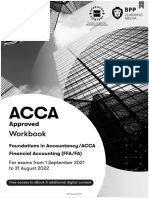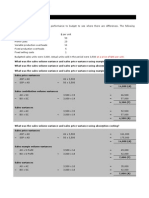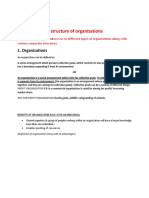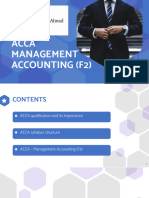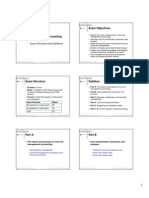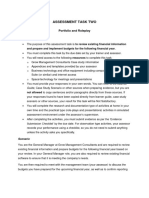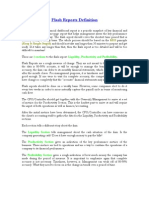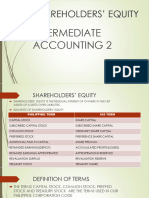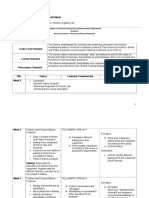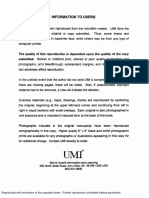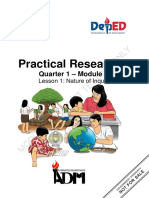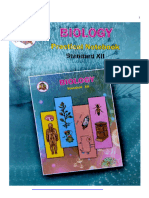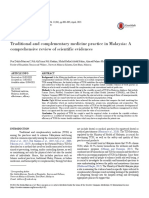Acca F2 Management Accounting: June2015
Acca F2 Management Accounting: June2015
Uploaded by
keerthana_giri8772Copyright:
Available Formats
Acca F2 Management Accounting: June2015
Acca F2 Management Accounting: June2015
Uploaded by
keerthana_giri8772Original Title
Copyright
Available Formats
Share this document
Did you find this document useful?
Is this content inappropriate?
Copyright:
Available Formats
Acca F2 Management Accounting: June2015
Acca F2 Management Accounting: June2015
Uploaded by
keerthana_giri8772Copyright:
Available Formats
ACCA F2
Management Accounting
June2015
Sample note
Accounting Practise Center (A.P.C) www.accaapc.com
1
© Lesco Group Limited, April 2015
All rights reserved. No part of this publication may be reproduced, stored in a retrieval system, or
transmitted, in any form or by any means, electronic, mechanical, photocopying, recording or
otherwise, without the prior written permission of Lesco Group Limited.
Accounting Practise Center (A.P.C) www.accaapc.com
2
Content
Introduction to management accounting ...............................................................................................5
Cost classification ....................................................................................................................................6
High low method: .................................................................................................................................16
Stock management ...............................................................................................................................11
Stock(inventory) valuation ....................................................................................................................29
Labour Cost System ...............................................................................................................................31
Absorption costing ................................................................................................................................38
Cost bookkeeping..................................................................................................................................44
Marginal costing....................................................................................................................................46
Job costing ............................................................................................................................................52
Pricing: ..................................................................................................................................................58
Service costing ......................................................................................................................................59
Alternative costing systems (introduction) ...........................................................................................60
Process costing ......................................................................................................................................64
Budget ...................................................................................................................................................75
Forecasting techniques .........................................................................................................................83
Investment appraisal techniques: .........................................................................................................92
Variance analysis .................................................................................................................................102
Performance management .................................................................................................................112
Accounting Practise Center (A.P.C) www.accaapc.com
3
Exam format in June2015:
Exam:
2hours
100 marks
50% pass mark
Structure:
Section A:
35 objective questions with 2 marks each
Section B:
3 multi task questions with 10 marks each and total 30 marks
Form budgeting, standard costing and performance measurement.
Containing multiple choice, response, response matching, number entry, gapfill and hotspot.
For the exam structure illustration, please watch this video produced by ACCA:
https://www.youtube.com/watch?v=UQIwbDX9z0w
Accounting Practise Center (A.P.C) www.accaapc.com
4
Introduction to management accounting
Accounting Practise Center (A.P.C) www.accaapc.com
5
Chapter1 Introduction to management accounting
Management accounting:
① is to provide useful information
② in assisting management
in the management activities③.
Overview:
If you want to open up a high fashion clothes manufacturing company in India so what
you should do?
Information required: internal & external
-existing financial information?
-company resources-staff?
-government report/industry report
Management activities: use the above information in:
-Planning: Plan future activities, budget
-Decision making: Whether to set up company and what
further investment that company
may try to make
-Control: Variance-Compare results of
operation with expected(meet
sales/ cost target?)
①Difference between Management accounting & Financial Accounting
Idea: Management accounting is for the use of management to make decisions
Financial accounting is used for paying taxes, borrowing money from bank or
attracting investors.
Management accounting Financial Accounting
Use Internal External
Format Adapted Strict
Content Detailed Summary
(reflect past and future) (reflect past)
Information Financial+Non-financial Financial
Time Depends Per year
Accounting Practise Center (A.P.C) www.accaapc.com
6
② information
1, Difference between information and data
-Data + meaning=information
-If I give you data profit is $5,000 and you may think it’s good but what if I tell
you that company has a sales revenue of $50m and you may think that $5,000
is too small so you decide not to invest in this company.
-Without given context that $5,000 is just data(raw data) and you can’t make
your decision whether to invest in this company unless you are given
information, ie, incorporate the data with specific context(give some meaning
to it.)
2, How to assess whether this information is good?
Accurate They should be accurate not too vague and if you’re given information that
company has made profit this year but not told how much then it’s useless
to help you make decisions.
Cost efficient You should weigh the benefit you get after getting this information and the
cost you have to pay.
Complete If you are told that there’s a competitor emerging then you should need to
obtain its price and skills they have mastered as well.
User-focused Eg, a shop manager may wish to have a summary of the shop’s daily takings
and a sales manager may want detailed customers details to complete their
sales target.
Relevant If you want to know the price that competitor is currently charging so any
information provided about the history about the competitor may deem to
be irrelevant.
Authoritative The information should be reliable so if you are told that inflation rate this
year is 5% so you need to check where is this information coming from, eg,
from government report?
Timely Information must be produced in advance of the time when it’s needed. Eg,
budgets need to be set in advance of a period in order to compare with
actual performance as a benchmark.
Ease of use We need to make sure Information produced can be used by users, eg, easy
language.
Accounting Practise Center (A.P.C) www.accaapc.com
7
3, where does information come from?
Internal: wage rate; production rate; sales volumes.
External: government report; industry statistics.
Inflation rate; industry report.
Accounting Practise Center (A.P.C) www.accaapc.com
8
③management activities
Once we’ve looked at how to generate into information we now need to know where do
we use these information for and by.
Where:
The information should be used to management activities
Planning (budget); [regularly]
Decision making; (launch new products/enter into new market) [any time]
Control(variance analysis) [regularly]
By:
The information should be used by different level of management within the
business.
Strategic level (directors and senior management; more than 1year)
Tactical Level (divisional/departmental manager; somewhere between
1month-1year)
Operational Level (team leader; factory supervisor; daily/weekly)
Accounting Practise Center (A.P.C) www.accaapc.com
9
Centers:
To achieve better control over the organization, companies would always divide
themselves up into different centers.
Cost Center:
Break group costs into different areas like in products line; managers; location; region;
location; department;
Performance would be assessed using cost variance analysis.
Revenue Center:
Break group revenue into different areas like in products line; managers; location;
region; location; department. Eg, Sales department.
Performance would be assessed using revenue variance analysis.
Profit Center:
Senior management here will control both revenue and costs in order to maximize
profit. Usually this would be divisions within organization.
Performance would be assessed using cost&revenue variance analysis, focusing on
controllable profit.
Investment Center:
They are not only responsible for control over revenue and costs but also for some
capital. This would be done by quite senior persons within business usually.
Performance would be measured using returned on capital employed. Ie, focusing on
profit + capital employed(capital expenditure).
Accounting Practise Center (A.P.C) www.accaapc.com
10
Chapter2 Cost classification
Since we know that cost is important to business then we should try to control the costs
incurred within business.
Cost unit
A unit of product or services for which costs can be ascertained. These are usually classed
in relation to the unit the product is sold in.
Examples:
Petrol - per litre
Paint - per tin
Bread - per loaf
Using these cost units assist us being able to cost the products made. We also need to
identify service units. These will be discussed in the session on service costing.
Cost object
A cost object is anything that we want to know the cost of. We might want to know the
cost of making one unit of product, or a batch of product, or all of Tuesday’s production,
in which case the cost objects are one unit of product, a batch of product, or Tuesday’s
production, respectively. We might want to know the cost of operating a department or
a factory, in which case the cost object is the department or factory. In a service sector
company, we might want to know the cost of treating a patient in a hospital, or the cost
of conducting an audit, in which case the cost object is the patient or the audit client.
In a government setting, a cost object might be a program such as “Meals on Wheels.”
Accounting Practise Center (A.P.C) www.accaapc.com
11
Classification of costs:
Cost can be classified through the following 4 categories:
By Nature
By Traceability
By Cost behavior
By production & Non production costs
By nature:
This means that it can be classified as material costs, labour costs and other expenses.
By traceability:
This means that it can be classffied as direct cost and indirect cost.
Direct cost is the cost that can be traced back to the production of product.
Indirect cost is the cost that is difficult to be traced back to the production of product.
Typical direct cost: direct material and labour into production of product.
Typical indirect cost: electricity expenses
The sum of direct costs would be prime costs while the sum of indirect costs would be
overhead costs.
By costs behavior:
This means costs can be classified depending on different the behavior of costs at
different volume of production or sales.
The costs can be classified either variable costs or fixed costs .
Variable cost:
If the level of activity changes then cost changes.
If you produce more tables then you need more materials as well as labors.
Eg,direct material, direct labout, variable overhead(Repair and maintenance,
Power, fuel, Indirect labor etc.)
Fixed cost: Are the cost still incurred even though business is not operating .
Within variable costs it would be step costs and semi-variable costs.
Accounting Practise Center (A.P.C) www.accaapc.com
12
Total cost Variable
cost/unit
LofA LofA
Fixed costs: If the level of activity
changes then cost would not change.
Total
Fixed
costs
cost/unit
LofA LofA
Eg, rent bills; fixed salary.
Step costs: If the level of activity hits a point then fixed cost changes.
If the capacity of your factory doesn't satisfy the current production plan
then you need to open up a new factory and this
Total
costs
LofA
Accounting Practise Center (A.P.C) www.accaapc.com
13
Semi-variable costs: This is a cost containing both variable and fix element.
Example: phone bill(fixed connection fee and variable costs/call)
Total
costs
Fix
element
LofA
By production & non-production costs
Production cost: costs must be incurred to produce this products.
Material, labour, machine etc.
Forms cost of sales within Income Statement.
Non-production cost: costs not necessarily incur to produce products.
Tax expenses; administration expenses; finance cost etc.
Forms other expenses within Income Statement.
Profit or loss statement:
Sales revenue X
Costs of sales(production costs) (X)
Gross profit X
Other expense (non-production costs) (X)
Profit after tax X
Accounting Practise Center (A.P.C) www.accaapc.com
14
Example: Tonic Water
If you were to manufacture a bottle of tonic water:
Materials Labor Other expenses
Soda water Front line production workers Electricity
Sugar Factory supervisor Insurance costs
Aluminum -sales manager Utilities
Machine -human resource manager Royalties
Factory building
Lorry
Required:
State costs which can be classified under:
(i) Nature
(ii)Traceability
Answer:
Materials Labor Other expenses
(D)Soda water (D)Front line production workers (ID)Electricity
(D)Sugar (ID)Factory supervisor (ID)Insurance
costs
(D)Aluminum -sales manager (ID)Utilities
(ID)Machine -human resource manager (ID)Royalties
(ID)Factory building
(ID)Lorry
Accounting Practise Center (A.P.C) www.accaapc.com
15
High low method:
We can use high low method to separate fixed and variable cost within semi-variable
costs.
We assume a linear relationship that changes in totals cost are because of the changes
in the level of activities.
1, Total costs= total variable costs + total fixed cost
2, Total variable costs = variable costs/unit X level of activity
variable cost/unit = cost at highest level – cost at lowest level
Highest level activity-lowest level activity
3, Total fixed cost= total costs-total variable costs
4, Use formula to predict future costs given the level of activity.
Note: we must ensure that any variable cost/unit is constant and the total fixed cost is
constant as well.
Q Kenny (High low method)
Kenny manufactures bottles for tonic water and the following information is presented
as the output of the number of bottles that Kenny made and the related costs as well.
Output 65,000 units 105,000 units
Cost $133,000 $210,000
Required:
Use the above data calculate:
(i) The fixed and variable costs for Kenny;
(ii) The total costs if the output if 200,000 units.
Answer:
(i)Total costs= variable costs+ fixed costs
Variable costs= variable costs/unit X outputs
= 210,000-133,000
105,000-65,000 X output
=1.925 X65,000
=$125,125
fixed costs =$133,000(total cost)-$125,125=$7,875
(ii)total cost= total variable costs + total fixed cost
= $1.925 X 200,000units +7,875
Accounting Practise Center (A.P.C) www.accaapc.com
16
=$392,875
Q John (consider other costs as well)
John has the following total costs at two activity levels:
Output 17,000 units 22,000 units
Cost $140,000 $170,000
Variable cost per unit is constant in this range of activity and there is a step cost of
$5,000 in the total fixed costs when activity exceeds 19,000 units.
Required:
Use the above data calculate:
(i) The fixed and variable costs for John;
(ii) The total costs if the output if 21,000 units.
Answer:
Total costs= total variable costs + total fixed costs
Total variable costs= variable cost/unit Xoutput
= ($170,000-$5,000) - $140,000
22,000-17,000
=$5/unit X17,000units
=$85,000
Total fixed costs= total costs-total variable costs
=$140,000-$85,000
=$55,000
(ii) The total costs if the output if 21,000 units.
Total costs= total variable costs + total fixed costs
=$5/unit X 21,000 +$55,000 +$5,000(step costs)
=$165,000
Accounting Practise Center (A.P.C) www.accaapc.com
17
You might also like
- f2 Acca Fma BPP Kit 2021 For StudentDocument187 pagesf2 Acca Fma BPP Kit 2021 For StudentTranh Meow MeowNo ratings yet
- F3 Financial Accounting Int Revision Kit BPP PDFDocument2 pagesF3 Financial Accounting Int Revision Kit BPP PDFJeremy67% (3)
- ACCA F3 Financial Accounting BPP Revision Kit 2017 Freebooks - PKDocument314 pagesACCA F3 Financial Accounting BPP Revision Kit 2017 Freebooks - PKLinh Mit100% (8)
- ACCA F2 FormulasDocument1 pageACCA F2 Formulasabstract_art111740% (5)
- F2 - Past PapersDocument298 pagesF2 - Past Papersbilligee73% (11)
- 2021-2022 F3 (FFA - FA) Financial Accounting WorkbookDocument40 pages2021-2022 F3 (FFA - FA) Financial Accounting WorkbookNguyễn Mai50% (4)
- Level 3 - Management Accounting Costing - Question BankDocument288 pagesLevel 3 - Management Accounting Costing - Question Banktrue100% (2)
- ACCA F3 Course Notes PDFDocument436 pagesACCA F3 Course Notes PDFNagendra Krishnamurthy67% (3)
- Free CBE ACCA F3 Financial Accounting Mock ExamDocument15 pagesFree CBE ACCA F3 Financial Accounting Mock ExamACCALIVE82% (17)
- f2 Mock ExameDocument41 pagesf2 Mock ExameZuhaib Iqbal67% (6)
- MA2 - Workbook - Student Copy - Part 2 (CHP 11 - 19) Jan19 (EO)Document155 pagesMA2 - Workbook - Student Copy - Part 2 (CHP 11 - 19) Jan19 (EO)Linh Thuy100% (1)
- FIA Maintaining Financial Records FA2 BPP Learning Media BPP Learning MediaDocument10 pagesFIA Maintaining Financial Records FA2 BPP Learning Media BPP Learning Mediamamoona ehsan100% (1)
- ACCA F2 Final MocksDocument43 pagesACCA F2 Final Mocksadnan7985% (13)
- ACCA F2 VariancesDocument12 pagesACCA F2 VariancesLiam Bourke50% (2)
- Acca f2 MockDocument13 pagesAcca f2 MockAli Rizwan100% (1)
- ACCA F2 Management Accounting Course Companion, BPP Publishing - 2Document42 pagesACCA F2 Management Accounting Course Companion, BPP Publishing - 2humanity firstNo ratings yet
- ACCA F5 Course Notes PDFDocument330 pagesACCA F5 Course Notes PDFAmanda7100% (1)
- Acca F2Document13 pagesAcca F2Ravi KureemunNo ratings yet
- Chapter 1 ACCA F1Document14 pagesChapter 1 ACCA F1sikshaNo ratings yet
- 1695205417introduction To ACCA - Management AccountingDocument31 pages1695205417introduction To ACCA - Management AccountingDhanuja jayamalNo ratings yet
- ACCA F2 SyllabusDocument2 pagesACCA F2 SyllabussairambabailoveyouNo ratings yet
- ACCA - F2 Management Accounting CBE Based Mock ExamDocument14 pagesACCA - F2 Management Accounting CBE Based Mock ExamACCALIVE100% (4)
- F2 - Management Accounting Part B ClassDocument144 pagesF2 - Management Accounting Part B ClassNguyen Huong100% (4)
- ACCA F3 Workbook Q & A PDFDocument191 pagesACCA F3 Workbook Q & A PDFNerissa PasambaNo ratings yet
- Acca f7 Notes j15Document276 pagesAcca f7 Notes j15opentuitionID100% (3)
- ACCA F2 Course NotesDocument494 pagesACCA F2 Course NotesТурал Мансумов100% (5)
- WWW - Fetsystem.co M: Acca F1 Question BankDocument4 pagesWWW - Fetsystem.co M: Acca F1 Question BankMuhammad Umar Khan70% (10)
- ACCA F3 Integrated Financial Accounting Course Companion, BPP PublishingDocument44 pagesACCA F3 Integrated Financial Accounting Course Companion, BPP Publishingsmy890No ratings yet
- f3 Interactive Self Study GuideDocument23 pagesf3 Interactive Self Study GuideIskandar BudionoNo ratings yet
- Acca f2 Notes j15Document188 pagesAcca f2 Notes j15opentuitionID100% (2)
- F3 Mocks: Updated 2010-2011 and Onward As Per Kaplan (FTC) Book On F3Document75 pagesF3 Mocks: Updated 2010-2011 and Onward As Per Kaplan (FTC) Book On F3adnan79100% (7)
- Acca f1 BT Exam KitDocument207 pagesAcca f1 BT Exam KitC HZHNo ratings yet
- SBR Standards Complete 2020Document55 pagesSBR Standards Complete 2020Anjali100% (4)
- f1 SQB 15 SampleDocument17 pagesf1 SQB 15 SampleNithyananda PatelNo ratings yet
- Acca f3 Course Notes Financial AccountingDocument437 pagesAcca f3 Course Notes Financial AccountingLarbi PremiumNo ratings yet
- Acca F3Document144 pagesAcca F3iftikharali184% (19)
- Wiley CMA Learning System Exam Review 2013, Complete Set, Online Intensive Review + Test BankFrom EverandWiley CMA Learning System Exam Review 2013, Complete Set, Online Intensive Review + Test BankNo ratings yet
- Interview Base - Knowledge & PracticalDocument39 pagesInterview Base - Knowledge & Practicalsonu malikNo ratings yet
- BSBFIN 601 Task 2 V0357Document9 pagesBSBFIN 601 Task 2 V0357Catalina Devia CastiblancoNo ratings yet
- ACCA F5 Performance ManagementDocument18 pagesACCA F5 Performance Managementbillyryan1No ratings yet
- Cost and Management Accounting Unit 1 NotesDocument13 pagesCost and Management Accounting Unit 1 NotesAliyah AliNo ratings yet
- Mba Financial AssgDocument10 pagesMba Financial Assgseifu deraraNo ratings yet
- Assessing A CEO's Per Formance A Guide For Victorian Public Sector BoardsDocument64 pagesAssessing A CEO's Per Formance A Guide For Victorian Public Sector Boardseyyad2001No ratings yet
- Develop and Implement Business Plan TASK 2 - Business Performance MonitoringDocument15 pagesDevelop and Implement Business Plan TASK 2 - Business Performance MonitoringAYUSHI KULTHIANo ratings yet
- Financial Reporting Thesis PDFDocument6 pagesFinancial Reporting Thesis PDFUK100% (2)
- ch01 (Online Module)Document91 pagesch01 (Online Module)Nazmul Ahshan SawonNo ratings yet
- Putting Intelligent Insights To WorkDocument12 pagesPutting Intelligent Insights To WorkDeloitte Analytics100% (1)
- 1... FMA Assignment 2Document7 pages1... FMA Assignment 2kibur amahaNo ratings yet
- Finance Transformation in Action - An Essential Toolkit For Every CFODocument9 pagesFinance Transformation in Action - An Essential Toolkit For Every CFOCharles SantosNo ratings yet
- FP&A Interview Questions and AnswersDocument7 pagesFP&A Interview Questions and Answershrithikoswal1603100% (2)
- Balanced Score Card & Giving FeedbackDocument35 pagesBalanced Score Card & Giving FeedbacksupriyanairNo ratings yet
- Gemoknyer Soalan..Document6 pagesGemoknyer Soalan..Nurulizwa Bte Abdul RashidNo ratings yet
- Financial Accounting CourseworkDocument7 pagesFinancial Accounting Courseworkafjyadcjesbdwl100% (2)
- Module-5 2Document15 pagesModule-5 2Dia JulianaNo ratings yet
- Assess BSBFIM601 AustraliaDocument16 pagesAssess BSBFIM601 Australiasfh5pfxv4fNo ratings yet
- Q2 Entrep Module 4 Week 4 Revised2Final With Answer KeysDocument20 pagesQ2 Entrep Module 4 Week 4 Revised2Final With Answer KeysJade Barberan100% (1)
- Q2 - Entrep Module 4, Week 4 Revised2Final With Answer KeysDocument20 pagesQ2 - Entrep Module 4, Week 4 Revised2Final With Answer KeysFelipe Balinas40% (5)
- Flash Reports DefinitionDocument8 pagesFlash Reports Definitionca_rudraNo ratings yet
- Prevention of Substance Use and AbuseDocument14 pagesPrevention of Substance Use and AbuseDianne SagunNo ratings yet
- Logic and ProofDocument253 pagesLogic and Proofffernandes_46No ratings yet
- Accounting For Shareholders' EquityDocument131 pagesAccounting For Shareholders' EquityLeafar NagaliNo ratings yet
- 13th Age The Archmages Orrery PDFDocument64 pages13th Age The Archmages Orrery PDFRafael Aguilar Pérez100% (3)
- Rational Expressions - Assignment BookletDocument44 pagesRational Expressions - Assignment BookletRand AhmadNo ratings yet
- Collins-On The Date and Interpretation of de BCDocument21 pagesCollins-On The Date and Interpretation of de BCcabojandiNo ratings yet
- Syllabus Bread&Pastry PDFDocument6 pagesSyllabus Bread&Pastry PDFRoxanne Mamaclay100% (1)
- 21st Century Storage Acquires New Property in New YorkDocument2 pages21st Century Storage Acquires New Property in New YorkPR.comNo ratings yet
- Nego Week 4Document9 pagesNego Week 4kookNo ratings yet
- MGMT Skills 622 - Handouts - 1 - 45 PDFDocument135 pagesMGMT Skills 622 - Handouts - 1 - 45 PDFAnissa Negra AkroutNo ratings yet
- Best Coaching Center - AdjectivesDocument28 pagesBest Coaching Center - AdjectivesBest CoachingNo ratings yet
- Germaine Tailleferre (1892-198Document409 pagesGermaine Tailleferre (1892-198Katie JordonNo ratings yet
- (WN) ReZero - Arc 7 (Dark)Document2,953 pages(WN) ReZero - Arc 7 (Dark)Outcast GamerNo ratings yet
- Ielts Reading Question SheetDocument2 pagesIelts Reading Question SheetShahzeb HaiderNo ratings yet
- Firearm IdentificationDocument121 pagesFirearm IdentificationRenz GadzNo ratings yet
- 1 Sales Tax PQDocument55 pages1 Sales Tax PQrabilalinaveedNo ratings yet
- Med Comp 18052012Document88 pagesMed Comp 18052012Mian Muhammad RashidNo ratings yet
- Solution Manual For Managing in A Global Economy Demystifying International Macroeconomics 2nd Edition Marthinsen 128505542X 9781285055428Document36 pagesSolution Manual For Managing in A Global Economy Demystifying International Macroeconomics 2nd Edition Marthinsen 128505542X 9781285055428daniellecolemizeadcokp100% (42)
- Practical Research 1: Quarter 1 - Module 1Document23 pagesPractical Research 1: Quarter 1 - Module 1Voltaire Swag100% (1)
- Xii Biology Practical 22 23Document119 pagesXii Biology Practical 22 23vaibhav.desai1007No ratings yet
- TCM Practice in Malaysia-A Comprehensive Review of Scientific EvidencesDocument5 pagesTCM Practice in Malaysia-A Comprehensive Review of Scientific EvidencesdalilaNo ratings yet
- CWA Strike & Defense Fund RulesDocument18 pagesCWA Strike & Defense Fund RulesLaborUnionNews.comNo ratings yet
- Swamy Rajesh - GCP - 1658473793365 - Swamy Rajesh Manugula (Repaired)Document3 pagesSwamy Rajesh - GCP - 1658473793365 - Swamy Rajesh Manugula (Repaired)Manugula SwamyRajeshNo ratings yet
- BPPTDocument11 pagesBPPTkishore ortanNo ratings yet
- Application For United Kingdom Passport For Applicants Under 16 (FORM C2)Document4 pagesApplication For United Kingdom Passport For Applicants Under 16 (FORM C2)Moiz RajputNo ratings yet
- Kurinjimala Wildlife Sanctuary - Management Plan 2012-22Document77 pagesKurinjimala Wildlife Sanctuary - Management Plan 2012-22akhil.sivadasNo ratings yet
- Another Case StudyDocument7 pagesAnother Case StudyTed ChristensenNo ratings yet
- Resume Neha BaswarDocument2 pagesResume Neha BaswarSawrabh TaoriNo ratings yet
- Assignment:2 - AML 169 - Engineering Mechanics (B Arch) : Submit in A4 SheetsDocument3 pagesAssignment:2 - AML 169 - Engineering Mechanics (B Arch) : Submit in A4 SheetsKartik MauryaNo ratings yet
- DeJong's The Neurologic Examination 6th Edition Ebook All Chapters PDFDocument24 pagesDeJong's The Neurologic Examination 6th Edition Ebook All Chapters PDFarrakihafdis100% (6)





